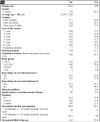Global Cardiovascular Risk Profile of Italian Medical Students Assessed by a QR Code Survey. Data from UNIMI HEART SURVEY: Does Studying Medicine Hurt?
- PMID: 33805103
- PMCID: PMC8037873
- DOI: 10.3390/jcm10071343
Global Cardiovascular Risk Profile of Italian Medical Students Assessed by a QR Code Survey. Data from UNIMI HEART SURVEY: Does Studying Medicine Hurt?
Abstract
Background: Few studies to date have addressed global cardiovascular (CV) risk profile in a "protected" young population as that of medical school students.
Objective: to assess CV traditional risk factors and global CV risk profile of Italian medical students throughout the six years of university.
Methods: A cross-sectional survey accessible online via quick response (QR) code was conducted among 2700 medical students at the University of Milan, Italy. Data on baseline characteristics, traditional CV risk factors, diet, lifestyle habits, and perceived lifestyle variations were evaluated across different years of school.
Results: Overall, 1183 students (mean age, 22.05 years; 729 women (61.6%)) out of 2700 completed the questionnaire (43.8% rate response). More than 16% of the students had at least 3 out of 12 CV risk factors and only 4.6% had ideal cardiovascular health as defined by the American Heart Association. Overweight, underweight, physical inactivity, sub-optimal diet, smoke history, and elevated stress were commonly reported. Awareness of own blood pressure and lipid profile increased over the academic years as well as the number of high-blood-pressure subjects, alcohol abusers, and students constantly stressed for university reasons. Moreover, a reduction in physical-activity levels over the years was reported by half of the students. Conclusion and Relevance: This study demonstrates that a "protected" population as that of young medical students can show an unsatisfactory cardiovascular risk profile and suggests that medical school itself, being demanding and stressful, may have a role in worsening of the lifestyle.
Keywords: QR code; cardiovascular risk factors; medical students; primary prevention; survey; young adult.
Conflict of interest statement
The authors declare no conflict of interest.
Figures




Similar articles
-
[Cardiovascular risk profile and lifestyle habits in a cohort of Italian cardiologists. Results of the SOCRATES survey].Monaldi Arch Chest Dis. 2013 Sep;80(3):118-25. doi: 10.4081/monaldi.2013.73. Monaldi Arch Chest Dis. 2013. PMID: 24818318 Italian.
-
Cardiovascular risk profile and lifestyle habits in a cohort of Italian cardiologists (from the SOCRATES Survey).Am J Cardiol. 2013 Jul 15;112(2):226-30. doi: 10.1016/j.amjcard.2013.03.020. Epub 2013 Apr 12. Am J Cardiol. 2013. PMID: 23587277
-
Cardiovascular Risk Factors Among Lower Silesian Students of the Faculty of Medicine: Knowledge and Distribution.Adv Clin Exp Med. 2016 Mar-Apr;25(2):341-7. doi: 10.17219/acem/33466. Adv Clin Exp Med. 2016. PMID: 27627569
-
Citizens and family doctors facing awareness and management of traditional cardiovascular risk factors: results from the Global Cardiovascular Risk Reduction Project (Help Your Heart Stay Young Study).Nutr Metab Cardiovasc Dis. 2003 Aug;13(4):211-7. doi: 10.1016/s0939-4753(03)80013-3. Nutr Metab Cardiovasc Dis. 2003. PMID: 14650353
-
Prevalence of cardiovascular disease risk factors among pharmacy students from Wroclaw Medical University (Poland).Adv Clin Exp Med. 2017 Aug;26(5):843-850. doi: 10.17219/acem/61439. Adv Clin Exp Med. 2017. PMID: 29068582
Cited by
-
Poor Health Behaviour in Medical Students at a South African University: A Cross-Sectional Survey Study.Int J Environ Res Public Health. 2024 Jun 24;21(7):824. doi: 10.3390/ijerph21070824. Int J Environ Res Public Health. 2024. PMID: 39063401 Free PMC article.
-
An Investigation into the Pressures Experienced by Medical Masters Students during the COVID-19 Pandemic Based on the Perceived Stress Scale-14 and Its Alleviation Methods.Healthcare (Basel). 2022 Jun 9;10(6):1072. doi: 10.3390/healthcare10061072. Healthcare (Basel). 2022. PMID: 35742123 Free PMC article.
-
Survey Response Rates to a Self-Initiated Longitudinal Survey Accessed by a Quick Response Code in Six Different Regions of the United States.Cureus. 2022 May 19;14(5):e25146. doi: 10.7759/cureus.25146. eCollection 2022 May. Cureus. 2022. PMID: 35747044 Free PMC article.
References
LinkOut - more resources
Full Text Sources
Other Literature Sources

